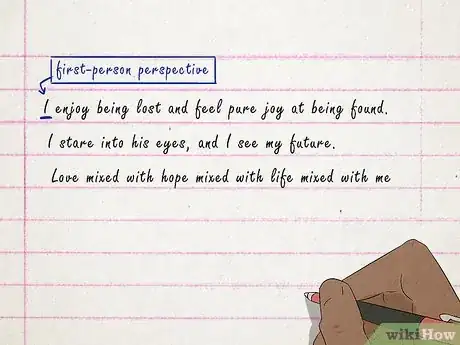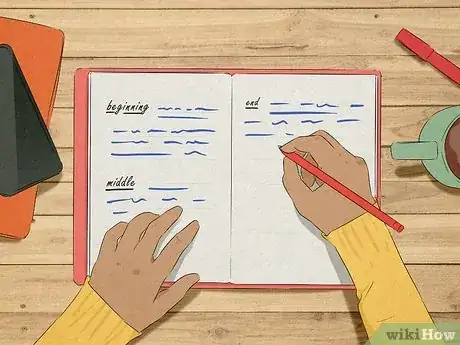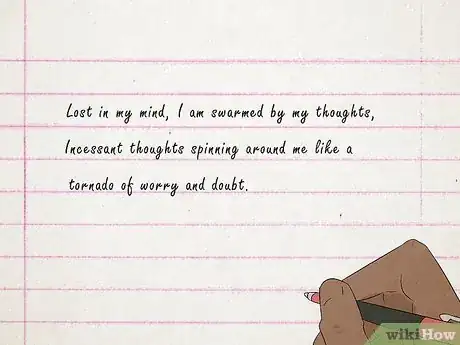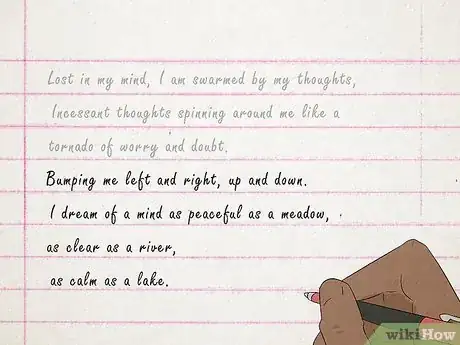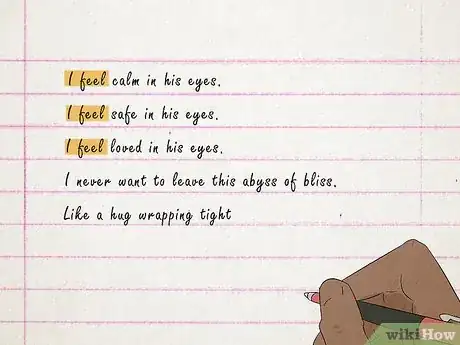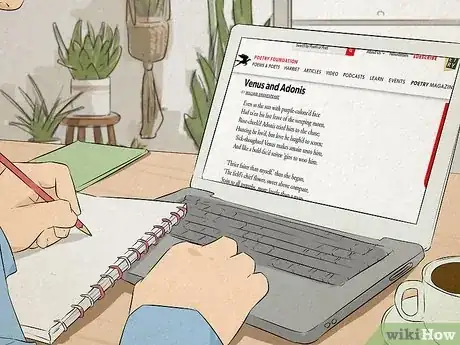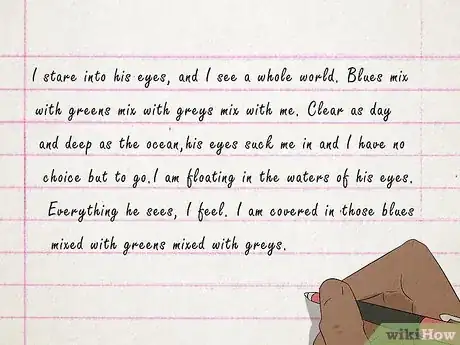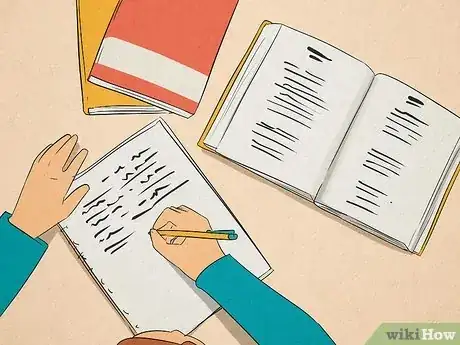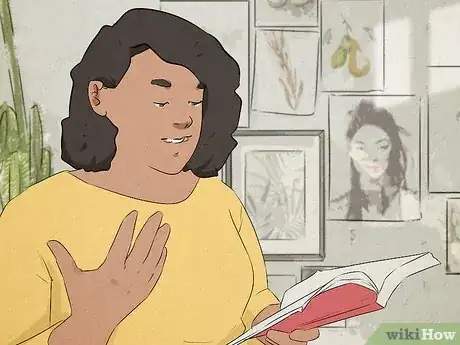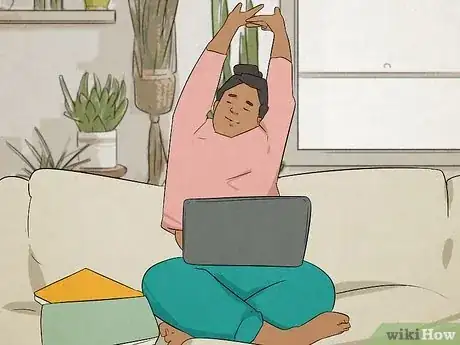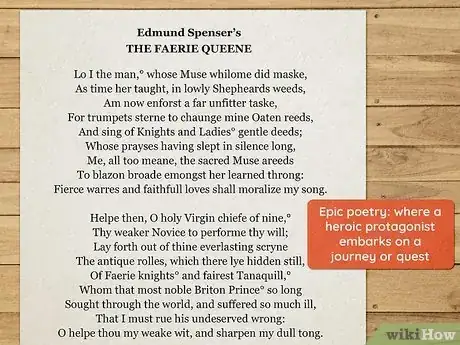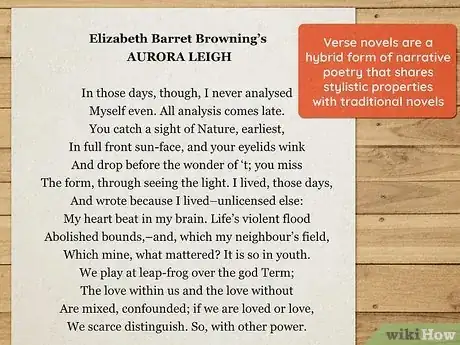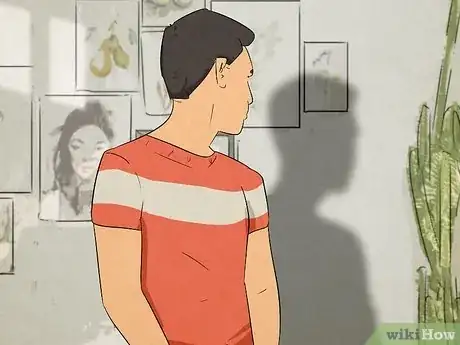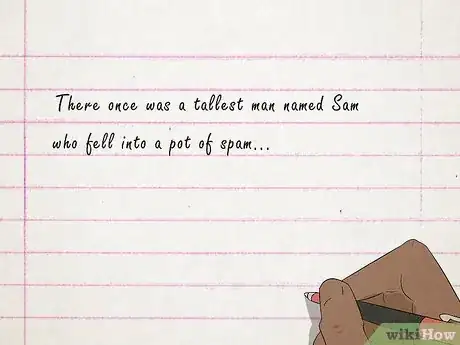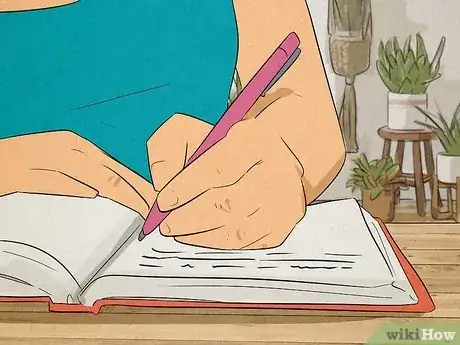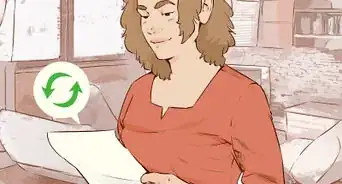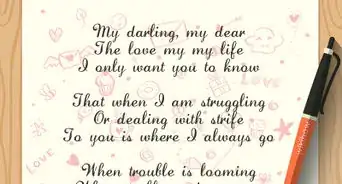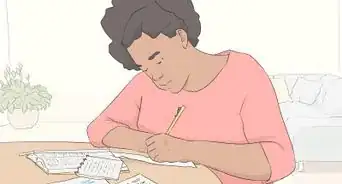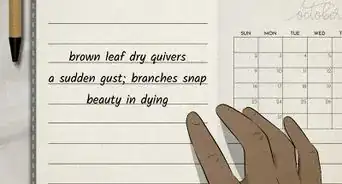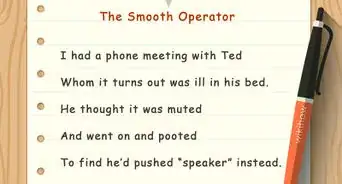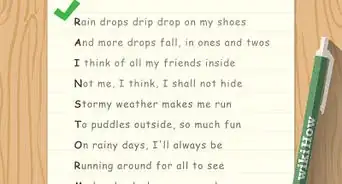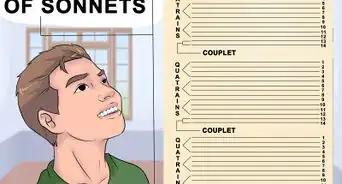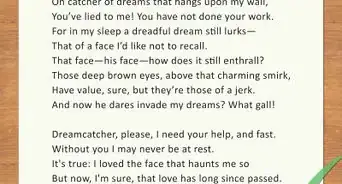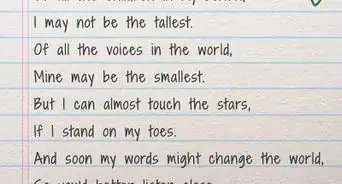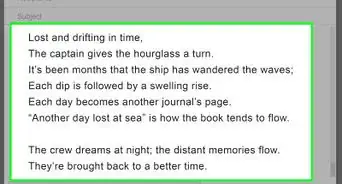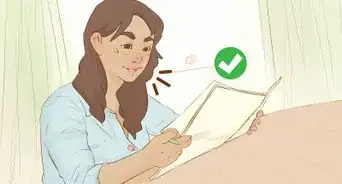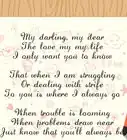This article was co-authored by Alicia Cook and by wikiHow staff writer, Aly Rusciano. Alicia Cook is a Professional Writer based in Newark, New Jersey. With over 12 years of experience, Alicia specializes in poetry and uses her platform to advocate for families affected by addiction and to fight for breaking the stigma against addiction and mental illness. She holds a BA in English and Journalism from Georgian Court University and an MBA from Saint Peter’s University. Alicia is a bestselling poet with Andrews McMeel Publishing and her work has been featured in numerous media outlets including the NY Post, CNN, USA Today, the HuffPost, the LA Times, American Songwriter Magazine, and Bustle. She was named by Teen Vogue as one of the 10 social media poets to know and her poetry mixtape, “Stuff I’ve Been Feeling Lately” was a finalist in the 2016 Goodreads Choice Awards.
There are 25 references cited in this article, which can be found at the bottom of the page.
This article has been viewed 85,093 times.
Have a swashbuckling tale or lover’s lament to get off your chest? Well, you’re in luck because narrative poetry is all about telling and sharing a story. This writing style and literary genre combines the plot devices of prose with the musical rhythms of poetry to craft a story that’ll hook any reader. In this comprehensive guide, we’ll tell you everything there is to know about narrative poetry, from what it is to how to write it. So, grab a pencil and get those creative juices flowing because we’ve got a narrative poem to write!
Steps
How to Write a Narrative Poem
-
1Choose a topic you feel strongly about. This doesn’t mean you have to pick a topic of activism or social justice. The story you choose to write should be something you want to write. Think about what you want to share with your readers. Maybe that’s a personal experience or feeling or a fictional romance full of magic and dragons.[4]
- Brainstorming ideas and storylines can help if you’re unsure what to pick. Try writing down everything that comes to mind—a memory, image, or place.[5]
-
2Find the speaker or narrator of your poem. Who is telling your story? Is it being told through a first-person or third-person perspective? Before you start writing your poem, discover who the leading character of your story is. Perhaps it’s you, a stranger, an animal, or a legendary hero.[6]
- A first-person perspective uses “I” and “me” to recall events that have happened or are happening to the character.
- A third-person perspective uses “she/her,” he/him,” and “they/them” to describe what the character is doing.
- Narrative poems can be written with any point of view or perspective; just be consistent throughout your narrative. As long as your narrator is the one telling the story, you’re golden.[7]
-
3Outline the beginning, middle, and end of your story. Narrative poetry is a form of storytelling verse, meaning a story must be told one way or another. Even if your narrative is of a single event, it must have a start and end. Your outline can consist of a few sentences or even bullet points—it’s there to help you flesh out your story before you write the verse.
- One of the main purposes of narrative poetry is to entertain. Unlike other forms of poetry, a narrative poem doesn’t drive a reader forward with feelings but with plot devices.[8]
- Brainstorm different possibilities for your characters, setting, and plot. What you write down isn’t set in stone.
- Some writers find that outlining during or after writing helps them more than outlining while brainstorming.
-
4Open the poem with a striking image or lyrical line. The first line of your narrative poem should immediately capture your reader’s attention. Draw them into your story by putting them in the middle of the action or painting a picture of how your leading character sees the world.
- For example, T. S. Eliot opens The Waste Land with the famous line “April is the cruellest month, breeding.” You’re instantly drawn into Eliot’s words as a reader, wondering why April is so cruel.
- There’s no set rule that a narrative poem has to start at the beginning of a story, so play around with your opening scene.
-
5Let the details drive the narrative. Many poems rely heavily on symbolism and description, and narrative poetry is no different. Try incorporating your five senses into your poem: what can you and your characters see, smell, taste, touch, and hear?[9]
- For example, in “The Fish,” Elizabeth Bishop describes a fish’s skin as “ancient wallpaper” and eyes as “tarnished tinfoil.” These descriptions help us as readers see what the narrator sees, putting us into the story.
-
6Strike your reader’s heart with repetition. One of the many advantages of telling a story through narrative poetry is that you can convey deeper emotions and feelings with poetic devices. Repeating phrases, words, and sounds appeals to the eye and ear and evokes emotion. Try adding alliteration, assonance, and consonance to your narrative poem to keep readers engaged and stress the importance of your message.[10]
- For example, in Edgar Allen Poe’s “The Raven,” the phrase “nothing more” is repeated as an allusion to the narrator’s deteriorating mental state.[11]
- Alliteration is the repetition of beginning stressed sounds through a series of words, like “swift, slow, sweet, sour.”[12]
- Assonance is the repetition of vowel sounds in the middle of words, such as “leaping” and “deep.”[13]
- Consonance is the repetition of words that share a similar sound, like “bed” and “bad.”[14]
-
7Add dialogue to your narrative poem. Playing with character conversations and dynamics can help you add relatability, charm, and depth to your narrative. There are no general rules for putting dialogue in poetry, but it is important to stay consistent. Choose whether you want speech to be in italics or quotation marks and stick to it. This will make it easier for your reader to follow along and stay immersed in the story.[15]
- Edmund Spenser chooses to use quotation marks in The Faerie Queene to separate the narrator’s voice from the characters’: “Saying, ‘yet O thou dreaded Dame, I crave / Abide, till I have told the message, which I have.’”
-
8End the poem with ambiguity. You and your friend could read the same poem and come across two different meanings, and that’s the beauty of poetry! Narrative poetry is no different as it can also be interpreted in multiple ways depending on the reader’s experiences and current emotions. Try ending your poem with open possibilities. Maybe the hero’s world goes black, and it’s uncertain if they’re dead or unconscious, or perhaps the sun sets to represent an end or a new beginning.
- Robert Frost’s narrative poem “The Road Not Taken” is famously known for having two interpretations: the speaker consciously makes a choice or fate led him down a particular path.
- Charlotte Perkins Gilman’s short story “The Yellow Wallpaper” also receives multiple interpretations; this prose example has been defined as a ghost story, exploration of mental illness, or combination of both.
Tips for Writing a Narrative Poem
-
1Read narrative poetry to get a sense of style. When you’re exploring a new genre or writing style, it’s always best to do a little research. Thankfully, narrative poetry has been around for centuries, so there are plenty of poems out there! Read poems from the 15th, 17th, or even 21st century:
- William Shakespeare’s Venus and Adonis
- Alexander Pope’s The Rape of the Lock
- David Ferry’s “The Soldier”
-
2Carry a notebook with you wherever you go. Inspiration for your narrative poem can strike from anywhere at any time. Start a writing journal to jot down notes and keep all your ideas in one place. Try keeping a small notebook and pen in your bag or making a folder for “poem ideas” in your phone’s notes app.[16]
- Take notes on whatever inspires you throughout the day. Maybe that’s a sunset, graffiti, or the smell of rain on pavement.
- Your notes don’t have to be detailed. Try jotting down a single word or even doodling an image—whatever will jog your memory later.
-
3Write the poem as prose first. If you're stuck on rhyme scheme, meter, and line breaks, try getting your story out without the poetic logistics.[17] Record yourself telling your story out loud or write it as a short story. This can help you find the narrative of your piece first, making it easier to convert everything to stanzas and lines later on.
- Prose generally refers to literature that's written in a straightforward manner that follows typical grammatical guidelines.[18] Basically, anything that isn’t written in verse is considered prose, such as short stories, essays, and books.
-
4Let yourself write. It can be easy to second guess your work and wonder if you’ll ever be good enough, but you can overcome writer’s block and imposter syndrome. The cure? Writing! Push those worries and fears aside by immersing yourself in your story.[19]
- Remember, there’s no right or wrong way to write poetry. Instead of sticking to a certain format or style right away, just let the words flow.
- Even the most famous poets will tell you that their best work didn’t happen overnight. It takes work and revision, but the best thing you can do is simply write.
-
5Read your poem out loud. Narrative poetry is a lyrical version of prose with verses, rhymes, and meter. If you’re not sure what to write next, go back and read aloud what you have written. Not only will this help get those creative wheels turning, but it’ll also help you find flaws in the rhythm and sound.[20]
-
6Take a break from the poem if you’re stuck. Sometimes, words don’t come to you, and that’s okay! Give yourself an hour break or set the poem aside for a day or two. Inspiration and new ideas will strike again in no time.
- Letting a poem sit for a while and even working on something else can allow you to return to it with a fresh perspective.
- Try going for a walk, listening to music, or reading on your break to get those creative wheels turning.
Community Q&A
-
QuestionHow can I make a creative story based off an existing poem?
 wikiHow Staff EditorThis answer was written by one of our trained team of researchers who validated it for accuracy and comprehensiveness.
wikiHow Staff EditorThis answer was written by one of our trained team of researchers who validated it for accuracy and comprehensiveness.
Staff Answer wikiHow Staff EditorStaff AnswerYou can certainly draw inspiration from a favorite or famous poem! Read the poem and ask yourself, "What do I like about this poem? What immediately stands out? What would I change if I could?" Use your immediate reactions to the poem to create your own version of the story. Think of it as a retelling, just be careful not to plagiarize.
wikiHow Staff EditorStaff AnswerYou can certainly draw inspiration from a favorite or famous poem! Read the poem and ask yourself, "What do I like about this poem? What immediately stands out? What would I change if I could?" Use your immediate reactions to the poem to create your own version of the story. Think of it as a retelling, just be careful not to plagiarize.
References
- ↑ https://writinguniversity.org/news-archive/2020/04/narrative-poetry
- ↑ https://examples.yourdictionary.com/reference/examples/narrative-poem-examples.html
- ↑ https://examples.yourdictionary.com/reference/examples/narrative-poem-examples.html
- ↑ https://powerpoetry.org/actions/how-write-narrative-poem
- ↑ https://blog.reedsy.com/guide/poetry/how-to-write-a-poem/
- ↑ https://powerpoetry.org/actions/how-write-narrative-poem
- ↑ https://facultyweb.cortland.edu/kennedym/genre%20studies/poetrynarrative.htm
- ↑ https://facultyweb.cortland.edu/kennedym/genre%20studies/poetrynarrative.htm
- ↑ https://powerpoetry.org/actions/how-write-narrative-poem
- ↑ https://poets.org/glossary/repetition
- ↑ https://www.owleyes.org/text/raven/analysis/literary-devices
- ↑ https://www.poetryfoundation.org/learn/glossary-terms/alliteration
- ↑ https://www.poetryfoundation.org/learn/glossary-terms/assonance
- ↑ https://www.poetryfoundation.org/learn/glossary-terms/consonance
- ↑ https://www.bethanyareid.com/can-i-use-dialogue-in-poems/
- ↑ https://www.dummies.com/article/academics-the-arts/language-language-arts/literature/writing-poetry-174006/
- ↑ https://blog.reedsy.com/guide/poetry/how-to-write-a-poem/
- ↑ https://writingexplained.org/grammar-dictionary/prose
- ↑ https://grammar.yourdictionary.com/grammar-rules-and-tips/tips-on-writing-poems.html
- ↑ https://blog.reedsy.com/guide/poetry/how-to-write-a-poem/
- ↑ https://www.poetryfoundation.org/learn/glossary-terms/epic
- ↑ https://poets.org/glossary/epic
- ↑ https://www.poetryfoundation.org/learn/glossary-terms/ballad
- ↑ https://www.poetryfoundation.org/learn/glossary-terms/quatrain
- ↑ https://guides.library.msstate.edu/c.php?g=826710&p=5963793
- ↑ https://www.poetryfoundation.org/learn/glossary-terms/meter
- ↑ https://www.poetryfoundation.org/learn/glossary-terms/verse
- ↑ https://poets.org/glossary/verse-novel
- ↑ https://www.poetryfoundation.org/learn/glossary-terms/stanza
- ↑ https://www.poetryfoundation.org/learn/glossary-terms/free-verse
- ↑ https://www.deanza.edu/english/creative-writing/prompts.html
- ↑ https://www.deanza.edu/english/creative-writing/prompts.html


